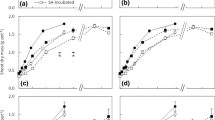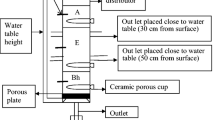Abstract
Phosphorus (P) is known to leach laterally in water flowing during winter over pasture growing on flat soils that are shallow sands over slowly permeable lateritic ironstone gravel or clay soils in the high rainfall (> 800 mm annual average) areas of south-western Australia. The climate is Mediterranean, with hot dry December to March and cool wet April to November growing season, with excess water flowing over the surface from June to early-August. Fertilizer P is presently applied at about mid-March, near the start of the growing season. Single superphosphate has been applied for many years, which has a good residual value, and so the soils are no longer acutely P deficient. Consequently, a better method may be to apply the fertilizer at mid-August, after waterlogging and P leaching have usually receded, and radiation and temperature are rising, so pasture growth is increasing. The field experiment reported here was on a shallow sand over lateritic ironstone gravel where lateral leaching of P occurs. The experiment compared from 1990 to 1994 the effectiveness of single superphosphate (SSP), the fertilizer used at present, and ‘coastal’ superphosphate (CSP), a partially acidulated rock phosphate containing about half the total P and one third the water-soluble P initially present in SSP. The fertilizers were applied annually either at mid-March or at mid-August. SSP applied at mid-March was the most effective treatment studied in the years when pasture plants had emerged before fertilizer was applied at mid-March. This is attributed to pasture plants being able to take up P from SSP applied at mid-March before leaching of P occurred, so that relative to SSP applied at mid-March, the other P fertilizer treatments (CSP applied at mid-march and mid-August, SSP applied at mid-August) were about equally or less effective. However, in years when the growing season had yet to start before fertilizer was applied at mid-March, then relative to SSP applied at mid-March, the other fertilizer treatments were equally or more effective. This is attributed to extensive leaching of P from SSP applied at mid-March, so that due to P losses from SSP applied at mid-March, the other treatments were equally or more effective. It is therefore concluded that profitable pasture production with reduced leaching is achieved by applying SSP at mid-March if soils are moist and pasture plants are growing at that time. However, if the soils are dry and no pasture plants are growing at mid-March, then CSP should be applied at mid-August.
Similar content being viewed by others
References
AOAC (1975) Official Methods of Analysis. 12th edn. Association of Official Agricultural Chemists, Washington DC
Babare AM, Gilkes RJ & Sale PWG (1997) Reactive phosphate rock dissolution, availability of dissolved phosphorus, and the relative agronomic effectiveness of reactive phosphate rock, as affected by phosphate buffering capacity and other soil properties. Aust J Exp Agric 37: 1037–1049
Barrow NJ (1966) The residual value of the phosphorus and sulphur components of superphosphate on some Western Australian soils. Aust J Exp Agric Anim Husb 6: 9–16
Barrow NJ (1980) Evaluation and utilization of residual P in soils. In: Khasawneh FE, Sample EC & Kamprath EJ (eds) The Role of Phosphorus in Agriculture, Ch 13, pp 333–359. Am Soc Agron, Madison, WI.
Barrow NJ & Campbell NA (1972) Methods of measuring residual value of fertilizers. Aust J Exp Agric Anim Husb 12: 501–510
Bolland MDA & Gilkes RJ (1990) Rock phosphates are not effective fertilizers in Western Australian soils: a review of one hundred years of research. Fert Res 22: 79–95
Bolland MDA & Gilkes RJ (1998) The relative effectiveness of superphosphate and rock phosphate for soils where vertical and lateral leaching of phosphate occur. Nut Cyc Agroecosystems 51: 139–153
Bolland MDA, Clarke MF & Boetel FC (1995a) Comparison of single and coastal superphosphate for subterranean clover on phosphorus leaching soils. Fert Res 40: 49–61
Bolland MDA, Clarke MF & Yeates JS (1995b) Effectiveness of rock phosphate, coastal superphosphate and single superphosphate for pasture on deep sandy soils. Fert Res 41: 129–143
Colwell JD (1963) The estimation of the phosphorus fertilizer requirement of wheat in southern New South Wales by soil analysis. Aust J Exp Agric Anim Husb 3: 190–197
Earle DF & McGowan AA (1979) Evaluation and calibration of an automated rising plate meter for estimating dry matter yield of pasture. Aust J Exp Agric Anim Husb 19: 337–343
Hodgkin EP & Hamilton BH (1993) Fertilizers and eutrophication in southwestern Australia: setting the scene. Fert Res 39: 95–103
Hughes JC & Gilkes RJ (1994) Rock phosphate dissolution and bicarbonate-soluble P in some soils of south-western Australia. Aust J Soil Res 32: 767–779
Loveday J (1974) Methods for analysis of irrigated soils. Commonwealth Bureau of Soils, Tech Comm No 939
Murphy J & Riley JP (1962) A modified single solution method for the determination of phosphate in natural waters. Anal Chim Acta 27: 31–36
Ozanne PG & Shaw TC (1967) Phosphate sorption by soils as a measure of the phosphate requirements of pasture growth. Aust J Agric Res 18: 601–612
Robson AD & Gilkes RJ (1980) Fertilizer responses (N, P, K, S and micronutrients) on lateritic soils in south-western Australia: a review. In: International Seminar on Laterization Processes. pp 381–390. Oxford and IBH Publishing Co, Oxford, UK.
Ross GJS (1980) MLP Maximum Likelihood Program. Rothamsted Exp Station, Harpenden, UK
Ruprecht JK & George PR (1993) Hydrology of the Peel-Harvey estuary catchment. Fert Res 36: 127–133
Sale PWG, Simpson PG, Lewis DC, Gilkes RJ, Bolland MDA, Ratkowsky DA, Gilbert MA, Garden, DL, Cayley JWD & Johnson D (1997) The agronomic effectiveness of reactive phosphate rocks 1. Effect of the pasture environment. Aust J Exp Agric 37: 921–936
Sims HJ & Andrew RA (1958) Superphosphate on wheat: time of application — its influence on yield. J Agric Victoria 56: 9–10
Smith AN (1965) When and how to apply superphosphate to wheat. Agric Gazette New South Wales 76: 200–203
Smith AN (1967) Late applications of superphosphate to wheat are ineffective. Agric Gazette New South Wales 78: 539–540
Walkley A & Black IA (1934) An examination of the Degtjareff method for determining soil organic matter and a proposed modification of the chromic and titration method. Soil Sci 37: 29–38
Weaver DM, Pen LJ & Reed AEG (1994) Modifying the phosphorus cycle to achieve management objectives in the Oyster Harbour Catchment. Water J 21: 28–32
Wild A (1958) The phosphorus content of Australian soils. Aust J Agric Res 9: 193–204
Yeates JS & Clarke MF (1993) Developing alternatives to phosphate fertilizers of high water solubility. Fert Res 36: 141–150
Yeates JS, Deeley DM, Clarke MF & Allen DG (1984) Modifying fertilizer practices. J Agric West Aust 25 (4th series): 87–91
Yuen SH & Pollard AG (1954) Determination of nitrogen in agricultural materials by the Nessler reagent. II. Micro-determinations in plant tissue and soil extracts. J Sci Food Agric 5: 364–369
Author information
Authors and Affiliations
Rights and permissions
About this article
Cite this article
Bolland, M., Clarke, M. & Boetel, F. Effectiveness of single and coastal superposphates applied either in autumn or spring. Nutrient Cycling in Agroecosystems 54, 133–143 (1999). https://doi.org/10.1023/A:1009785716375
Issue Date:
DOI: https://doi.org/10.1023/A:1009785716375




